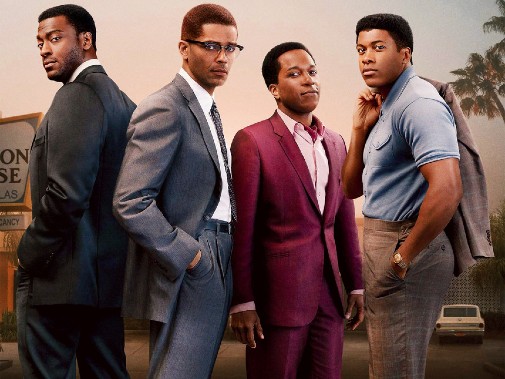
Limitations aren't always the enemy of style or art. Tight parameters can be the fertile ground from which creativity grows and thrives. In the world of costume design, the dynamic between restraint and imagination is especially obvious when one needs to dress men in formal attire. Since the early 19th century, western men's fashion has solidified around a masculine uniform with little in the ways of variation – the suit. To find ways to make that fashion standard into a storytelling tool, one must excel at finding the little details that make all the difference. Recently, Regina King's One Night in Miami is a good example of this brand of costuming excellence…

Negotiating the legacy of real-life icons and the story's historical setting, costume designer Francine Jamison-Tanchuck defined and differentiated the main players of One Night in Miami. They are Kingsley Ben-Adir's Malcolm X, Eli Goree as Cassius Clay, Aldis Hodge's Jim Brown, and Leslie Odom Jr. in the role of Sam Cooke. She used details of fit, textile, wear-and-tear, color, and cut to create individual characters one can recognize with a fleeting glance while still paying homage to the legends portrayed in the film. Each choice of attire makes a point about the men wearing it.
Adapted from a stage play by Kemp Powers, One Night in Miami has a limited scope in terms of chronology and location. That means that there aren't a lot of costume changes. In fact, most of the actors spend the majority of the movie in one suit. It's what they wear to celebrate the night when the fighter later known as Muhammad Ali became the world heavyweight champion in 1964. Because he has the flashiest costumes of the bunch and the most noticeable style evolution, let's start by examining the King of Soul.
When we first meet Cooke, playing a disastrous gig at the Copacabana, he's a vision in silver. In the dim room, he shines brighter than everyone else. Both the white-clad band and glamorously glittery patrons are overshadowed by Cooke's luminosity, figuratively and literally. He's a man of showbusiness, someone who enjoys and understands the value of drawing the eye of the gaze and keeping it on him. Later, off-stage, the same personality persists and is manifested in cloth. Though, as the film goes on, his glimmer diminishes.
Cooke wouldn't survive past 1964. While not calling too much attention to the tragic shrowd over the character, Jamison-Tanchuck does dress him as a dying flame, slowly losing light even as his conviction intensifies. On the night of the fight, silver has made way for a berry-colored suit and soft pink shirt, a silk cravat adorning his neck. It's ostentatious but not blinding and the same is true of the outfit with which he closes the movie. He sings "A Change Is Gonna Come" in a sharkskin suit that could be appropriate for a funeral if not for some stylish additions. Specifically, Odom Jr. wears cufflinks that are copies of a pair Cooke was gifted by the owner of the Copacabana.
A big part of the film concerns the tension between the singer and Malcolm X, a collision of different perspectives from people on the same side of the fight. Reproducing the activist's iconic figure, Jamison-Tanchuck dressed Ben-Adir in simple dark suits. They are old pieces, chosen for their functionality rather than their exquisiteness. Only the skinny ties look new, perchance a wifely gift with sentimental. Still, there's a sense of style to his sartorial choices, a sleek fit that makes Malcolm into a severe line cutting across the frame.
One Night in Miami's Jim Brown also dons black for most of the story, despite entering it in mustard yellow. Not every costume in the flick was reproduced from what the real people wore but Hodge's three-piece suit is directly inspired by what Brown was modeling on the night of the fight. It's a sharp professorial look that deflects attention from the wearer's musculature and draws his silhouette in boxy rectilinear shapes. He's a solid presence, his image projecting strange wisdom that makes him off to be a counter-argumentative voice of reason when dealing with his friends' conflicts.
The dying fire of a star, a black line, a box of solid support. Our final piece is a muscular spotlight.
He might spend his first scenes in boxing shorts but, after his character's victory, Eli Gooree dons a spiffy suit. Clay's outfit highlights his youth as well as his attention-pulling personality. The tan suit with a shot of green worn over a relaxed polo shirt is more casual than the ensembles of his companions, that's for sure. However, it also envelops his body in ways that let us ogle his physique and allow him to show-off his flexing muscles. He's proud and vibrating with power, the lighter colors of his clothes making it appear like there's a stage light pointed at him whenever he's alone with his dark-suited friends. If anything, his costuming arc represents a containment of that bright light, youthful bravado putting on a black suit similar to Malcolm's.
Overall, the four men appear dressed in a conservative style, their clothes a social armor that demands respect. They are framed within a period of stylistic transition when each of these legends was a combatant in the fight for civil rights, donning the look of the establishment to dismantle it. Nevertheless, Francine Jamison-Tanchuck has created a sartorial dialogue between each figure, complementing Powers' text, King's direction, and the cast's performances. She's a veteran designer who's been at this for over 40 years and even helped costume Jim Brown himself, so it's great seeing her work be appreciated in such a buzzy movie in contention for Oscar gold.
What other films make great use of classic suiting as costume?




